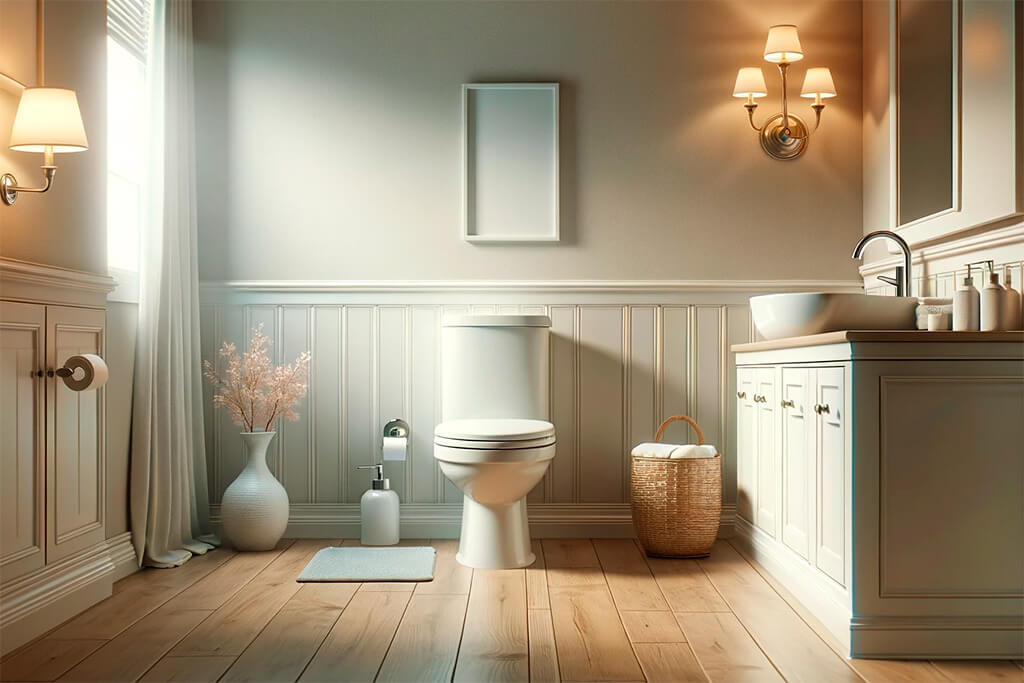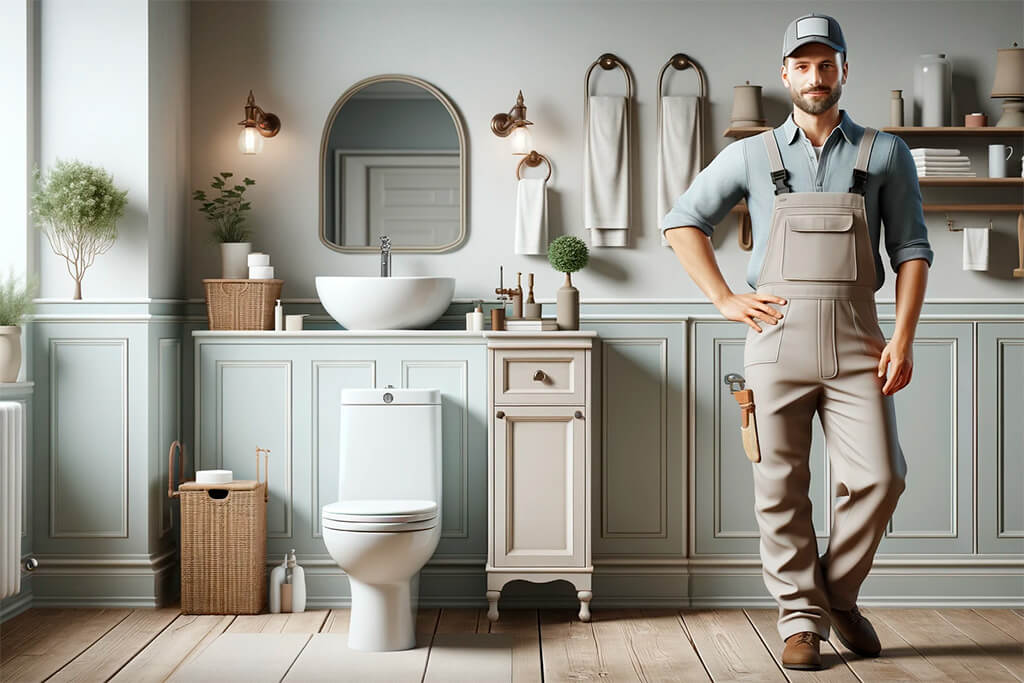In the vast landscape of home renovation, the seemingly simple task of installing a toilet carries far more weight than one might think. It isn’t merely about affixing a ceramic piece to the floor, it’s about setting up a critical component of home comfort. Get it right, and you’ll enjoy years of hassle-free utility. Falter, and you’ll grapple with leaks, structural damage, and more than your fair share of headaches.
Let’s embark on this journey, rooted in decades of hands-on experience, to ensure your toilet installation stands the test of time.

Preparation Steps
Gathering Your Arsenal – Tools and Materials
- Tools:
- Adjustable wrench: An essential companion for any renovation task, this tool ensures that nuts and bolts are secured with precision.
- Level: Guaranteeing a balanced installation, this tool can make the difference between a stable fixture and a teetering disaster.
- Tape measure: Accurate measurements form the backbone of successful installations.
- Plumber’s putty and caulk: These sealants bridge the tiny gaps, ensuring there’s no room for unwanted leaks.
- Hacksaw: Occasionally, you’ll find a bolt that overshoots its welcome, this tool will keep it in check.
- Materials:
- New toilet: This comprises the bowl, tank, and seat. It’s the centerpiece of our task.
- Wax ring: A small component, this plays a big role in preventing water leakage.
- T-bolts and washers: These are the anchors that hold the unit steadfast to the ground.
- Supply line: This connects to your water source.
Here’s a nugget of wisdom garnered from numerous renovation endeavors: the quality of your materials, especially ones like the wax ring, can make or break your installation. It’s more than just an accessory, it’s your first line of defense against leaks.

Choosing the Right Porcelain Throne for Your Loo
Venturing into the world of toilets reveals a spectrum of choices:
- Size and Style: The range is diverse, from compact round versions suitable for tighter spaces to elongated ones designed for comfort. There are single-piece units and the more traditional two-piece ones. Your decision here should echo both aesthetics and practicality.
- Rough-in Measurement: This is the unsung metric in toilet installation. The distance, usually from the wall to the center of the drain hole, is typically 12 inches. However, older homes with their quirks might surprise you with 10 or 14 inches. Always measure, then measure again. A mismatch here can derail the entire process.
Laying the Groundwork – Prepping the Installation Site
- Flange Check: Begin with the flange. This component must be level and undamaged. If it’s showing signs of wear, it would be prudent to replace it. Many a time, an overlooked flange has been the Achilles’ heel of an otherwise perfect installation.
- Clean Slate: A pristine working area is not just pleasing to the eye but also crucial for the task at hand. Remove any remnants of old wax, ensure the floor is spotless, and confirm its dryness. Preparation, though labor-intensive, often determines the longevity of your work.
- Plumbing Assessment: Before diving in, cast a critical eye over your plumbing. Ensure the drains are clear and the supply lines are intact. A preemptive check can save hours of remediation later.

The Installation Process
Laying the Foundation: The Wax Ring
The wax ring might seem inconspicuous, but it serves an essential function. Think of it as the sealing agent that stands guard against unwanted leaks. Over time, I’ve found this component to be the cornerstone of a successful installation.
- Importance of the wax ring: It’s the barrier between your bathroom floor and potential water damage. A well-set ring ensures your toilet and floor remain leak-free.
- Proper positioning and setting techniques: Always place the ring centered over the flange, aligning it just right over the hole. A hint from past installations: a slightly warmed ring is easier to mold and set, guaranteeing a tighter fit.
Assembling the Beast: Toilet Assembly
Putting together a toilet might feel like piecing together a sophisticated puzzle. The key lies in ensuring every component meshes seamlessly.
- Assembling the toilet tank and bowl: Start with the bowl facing down. Gently align the tank over it, making sure the mounting holes coincide. The bolts should slide in smoothly without force.
- Tips for ensuring a secure connection: Double-check the rubber gaskets. Positioned correctly, they’ll act as your first line of defense against leaks between the tank and bowl.

Positioning the Throne: Setting the Toilet
When placing the toilet, precision is everything. A misstep here can cause issues down the line.
- Aligning with the flange bolts: Guide the bowl steadily, ensuring the mounting bolts penetrate through the base holes perfectly.
- Pressing down: Applying even pressure, preferably by sitting, helps the wax ring adapt to its new position, ensuring a watertight seal.
Locking It In: Securing the Toilet
Once in position, the toilet needs to be anchored firmly, ensuring no unexpected movements or wobbles.
- Tightening the flange bolts: Apply even pressure when tightening. An overtightened bolt can lead to cracks or, worse, breakage.
- Ensuring stability: Test the stability of your installation. Any movement suggests the need for shimming for enhanced stability.
The Lifeline: Connecting the Water Supply
Here, precision and the right materials combine to bring life to your toilet.
- Choosing the right supply line: A braided steel line, with its durability and resistance to kinks, has proven time and again to be the optimal choice.
- Connecting to the fill valve and shut-off valve: Hand-tighten first. A wrench can then be used but remember – it’s about securing, not straining the connection.
The Moment of Truth: Final Checks and Testing
Every master craftsman knows the importance of revisiting their work. This is where we ensure everything functions as it should.
- Testing the flush: Once the tank fills, a flush will indicate whether the installation was a success. Keep an eye out for any anomalies.
- Checking for leaks: Look around the base, the tank, and listen closely. Even the slightest hint of moisture or a trickle sound calls for immediate attention.
- Making necessary adjustments: Ensure optimal water levels in the tank and bowl. Minor tweaks can lead to a perfect flush.
Post-Installation
A Seamless Finish: Caulking the Base (Optional)
While there’s debate over caulking, its advantages in both aesthetics and functionality can’t be overlooked.
- Benefits: Beyond a cleaner finish, it acts as a shield, preventing external moisture from sneaking in.
- Application techniques: Opt for waterproof caulk. Applying it evenly around the base and smoothing ensures not just functionality but also an elegant finish.

For a Lasting Reign: Maintenance and Care
A well-installed toilet can last a lifetime if given the right care. Regular maintenance is a small investment for long-term returns.
- Regular cleaning: Consistent cleaning using gentle agents keeps the toilet in optimal condition and extends its life.
- Ensuring longevity: Periodic checks of the flapper, fill valve, and float can preempt many common issues, saving time and money in the long run.
FAQ Section
For those seasoned in the trade, a new toilet can be up and running in about an hour or two. But if you’re venturing into this territory for the first time, allow yourself a generous 3-4 hours. This provides ample time for careful assessment, ensuring each step is done correctly, and even taking a brief respite. The goal isn’t speed, but precision.
A wobbling toilet typically indicates an uneven floor or loosely secured flange bolts. To rectify this, shims are your best friend. They’re tapered pieces, often made of plastic or metal, that can be wedged between the toilet and the floor to ensure stability. Once you’ve achieved a firm setting, simply trim away any protruding shim material, and you’re set.
Wax rings don’t require routine replacements like some parts of your home might. Generally, a wax ring’s life is replaced either when the toilet is or when there’s a noticeable leak at the base. A sage piece of advice: if you ever lift the toilet for any reason, replace the wax ring. It’s a small investment against potential water damage.
First, remain calm and locate the source. If the leak emerges from the base, it’s likely the wax ring. If it’s originating from the tank, inspect the connecting bolts and gaskets. It’s always a good idea to have some plumber’s putty or tape within arm’s reach. They’ve turned potential disasters into minor fixes for me more times than I can count.
I’ve come across some old bolts that seem sturdy enough for another round, but I’ve always erred on the side of caution. These bolts anchor your toilet, so why gamble? For the modest price of new bolts, you get peace of mind.
